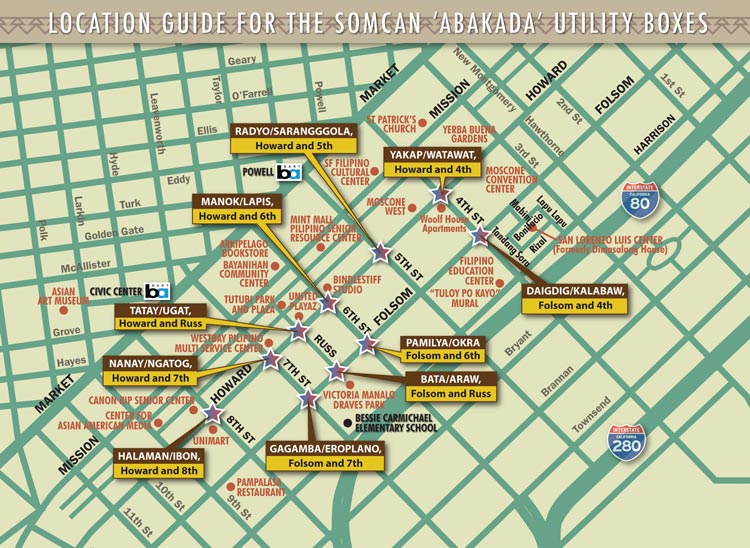
THOSE walking down Folsom and Howard streets in San Francisco’s South of Market (SOMA) neighborhood can get a brief lesson in the Abakada alphabet, which was once taught as part of the Philippine national language.
Entitled the “We Live Here” project, 10 utility boxes depicting letters from the alphabet were recently unveiled during a ribbon-cutting ceremony on Wednesday, October 6 along the two streets in the neighborhood as the city celebrates October as Filipino American History Month.
The project, which comes after years of advocacy, aims to teach the community about the alphabet, as well as to amplify the work of FEC Galing Bata, an after school program of the Bessie Carmichael School PreK-8/the Filipino Education Center.
“For over a century, Filipino American organizations have been serving the BIPOC community of the SOMA. This project serves as an example of community empowerment through education. Historically, the different Filipino American organizations have been providing services that instill vital linguistically and culturally responsive services and resources in the SOMA to address the needs of immigrant and multi-racial families, and FEC Galing Bata and the Filipino Education Center are some examples,” South of Market Community Action Network (SOMCAN)’s Lian Ladia, who facilitated the project, said.
Under the collaboration between SOMCAN and FEC Galing Bata, community meetings were held to choose the designs and what would be illustrated on the boxes.
“Aside from it being a learning tool, we believe that these flashcards showcase the long-lasting history and continuous presence of the Filipinos in San Francisco. The sentiment behind this project was to expose everyone, enrich the youth, engage families, and empower the community,” FEC Galing Bata teachers Shari Sarinas and Mark Belocura said.

Bay Area multimedia artist Mel Vera Cruz was commissioned to create the art, which would represent the 20 letters, essentially in a style similar to alphabet flashcards.
Abakada — which was developed by Filipino scholar Lope K. Santos in Ang Balarila ng Wikang Pambansa (The Grammar of the National Language) — bears 15 consonants and five vowels to represent the sounds of the Tagalog language. It was officially adopted in 1940 and remained the national language in the Philippines until 1976 when the Philippine Department of Education, Culture and Sports expanded the alphabet with 11 letters. The current 28-letter Filipino alphabet was institutionalized after the signing of the 1987 Constitution.
Each utility box bears two letters, and are represented by a Tagalog word and illustration, such as radyo (radio), saranggola (kite), watawat (flag), and yakap (embrace). The sides are wrapped with designs mimicking traditional Filipino textiles.
“The idea was to communicate a collective spirit and empower those while they’re walking around the neighborhood and they can say, ‘We are here, we are proud,’” Vera Cruz told the Asian Journal. “It’s our time to promote our culture and continue to share our history in SOMA.”
The organizations involved with this project also hope it will bring awareness to the community’s struggles, which includes fighting for the Filipino language immersion program under the San Francisco Unified School District.

| Photo courtesy of SOMCAN
In September, SFUSD staff recommended against the dual language immersion program at Bessie Carmichael/Filipino Education Center, which would require at least half of the daily instruction in Filipino, due to a lack of resources and conflicting visions.
“In 2014, San Francisco certified Filipino as the city’s official third language. However, when we conducted an evaluation and assessment report in 2018, what we saw was Filipino language access has been unevenly delivered across city departments and agencies and not fully supported in institutions like SFUSD,” said SOMCAN Director Angelica Cabande.







